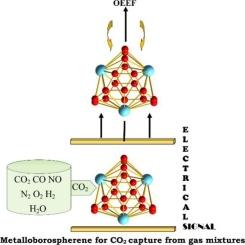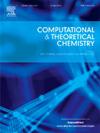An in-depth theoretical exploration of metalloborospherene-based sensors for selective CO2 capture from gas mixtures
IF 3
3区 化学
Q3 CHEMISTRY, PHYSICAL
引用次数: 0
Abstract
Density functional theory (DFT) calculations are performed to investigate metalloborospherenes, La3B18 and La3B18− nanoclusters, as high-efficiency materials for gas sensing applications. The main objective of this study is to assess the ability of metalloborospherenes to detect and capture CO2 from gas mixtures, including O2, N2, H2, CO, and NO. Our results reveal that CO2 adsorption significantly alters the electronic structure of La3B18−, whereas O2, N2, H2, NO, and CO adsorption exhibit negligible effects. CO2 adsorption results in a significant enhancement of the band gap, increasing by approximately 39 % for La3B18 and 85 % for La3B18− nanoclusters. This adsorbate-induced modulation of the band gap directly influences the sensor's electrical conductivity. The resulting change in conductivity generates an electrical signal, thereby enabling the detection of CO2 presence. Further analysis was conducted on the application of oriented external electric fields to enhance sensor recovery.

从气体混合物中选择性捕获二氧化碳的基于金属硼球烯传感器的深入理论探索
密度泛函理论(DFT)计算研究了金属硼球,La3B18和La3B18 -纳米团簇,作为气敏应用的高效材料。本研究的主要目的是评估金属球状体检测和捕获气体混合物中CO2的能力,包括O2、N2、H2、CO和NO。结果表明,CO2吸附显著改变了La3B18−的电子结构,而O2、N2、H2、NO和CO吸附的影响可以忽略不计。二氧化碳吸附导致带隙显著增强,La3B18纳米簇的带隙增加约39%,La3B18 -纳米簇的带隙增加约85%。这种吸附诱导的带隙调制直接影响传感器的导电性。由此产生的电导率变化产生电信号,从而能够检测CO2的存在。进一步分析了定向外电场在提高传感器回收率方面的应用。
本文章由计算机程序翻译,如有差异,请以英文原文为准。
求助全文
约1分钟内获得全文
求助全文
来源期刊

Computational and Theoretical Chemistry
CHEMISTRY, PHYSICAL-
CiteScore
4.20
自引率
10.70%
发文量
331
审稿时长
31 days
期刊介绍:
Computational and Theoretical Chemistry publishes high quality, original reports of significance in computational and theoretical chemistry including those that deal with problems of structure, properties, energetics, weak interactions, reaction mechanisms, catalysis, and reaction rates involving atoms, molecules, clusters, surfaces, and bulk matter.
 求助内容:
求助内容: 应助结果提醒方式:
应助结果提醒方式:


